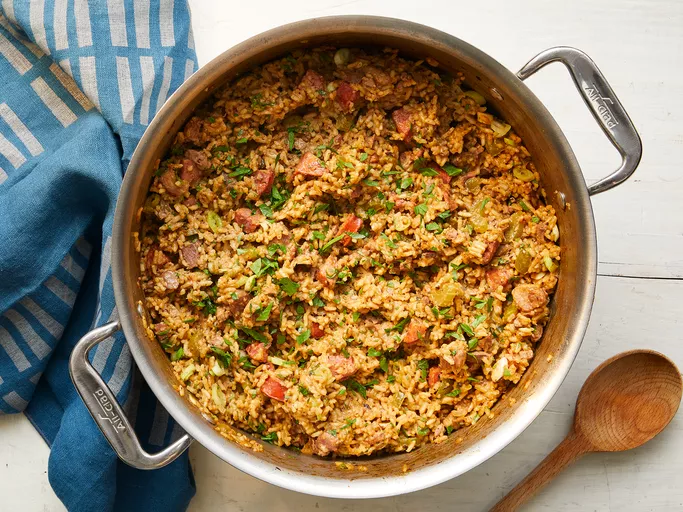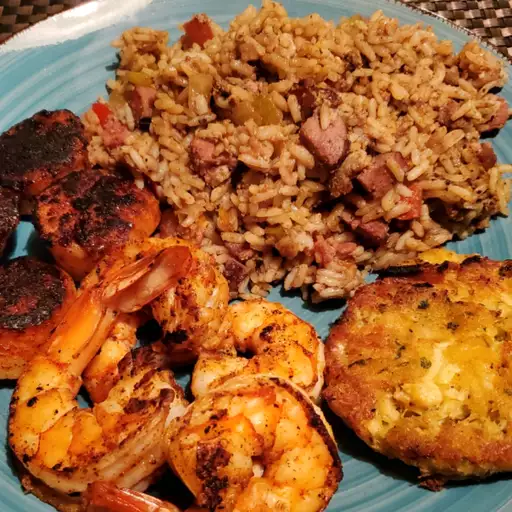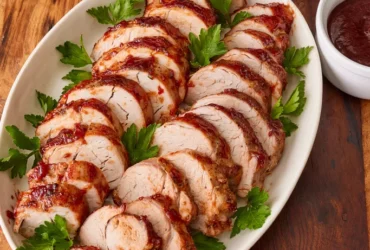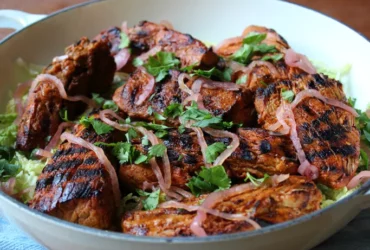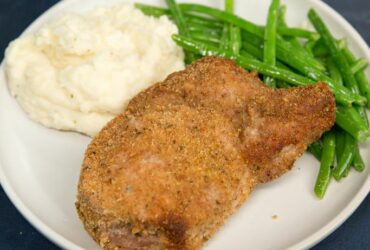Ingredients
Cooked rice: You’ll need 2 cups of cooked white or brown rice for this recipe.
Rice is a staple ingredient in many cuisines around the world, and it’s often used as a base for various dishes. In the context of the Dirty, Dirty Rice recipe, you’ll need to start with some cooked rice as the foundation.
The type of rice you choose will ultimately depend on your personal preference and the flavor profile you’re aiming for in your dish. Here are some options:
- White Rice: White rice is a classic choice for many recipes, including Dirty, Dirty Rice. It’s light, fluffy, and easily absorbs flavors.
- Brown Rice: Brown rice, on the other hand, has a nuttier flavor and chewier texture compared to white rice. It’s also higher in fiber and nutrients.
For this recipe, you’ll need 2 cups of cooked white or brown rice. You can use leftover rice from previous meals or cook fresh rice according to package instructions. Once the rice is cooked, it’s essential to let it cool completely before using it in your Dirty, Dirty Rice dish.
This allows the flavors to meld together and prevents the rice from becoming mushy or sticky. Additionally, you can toast the rice lightly in a pan with some oil to enhance its flavor and texture before adding other ingredients to create a more complex and savory taste experience.
Sausages: Choose your favorite type, such as smoked sausage like Andouille or kielbasa, and slice it into bite-sized pieces.
When it comes to choosing a type of sausage for a dirty rice recipe, the possibilities are endless. For those who prefer a smoky flavor, smoked sausages like Andouille or kielbasa are excellent choices.
Andouille is a classic Louisiana-style smoked sausage that adds a rich, spicy flavor to any dish. It’s made with pork, tripe, and spices, and is typically smoked over oak wood for a deep, complex flavor.
Kielbasa, on the other hand, is a Polish-style smoked sausage that’s made with pork and beef. It’s known for its garlicky flavor and firm texture, making it a great addition to dishes like dirty rice.
For those who prefer a milder flavor, you can also try using Italian sausage or Chorizo. Italian sausage is made with pork and seasoned with fennel seeds, anise, and other spices for a mild, slightly sweet flavor.
Chorizo, which is a Spanish-style smoked sausage, has a slightly spicy flavor thanks to its blend of paprika and chili peppers. It’s a great choice if you like a little heat in your food.
No matter which type of sausage you choose, it’s essential to slice it into bite-sized pieces before adding it to the dirty rice recipe. This will ensure that the flavors are evenly distributed throughout the dish and that each bite is packed with flavor.
Vegetables: Add diced onions, bell peppers, and celery to the pot for added flavor and nutrients.
To take this dirty rice recipe to the next level, it’s essential to incorporate an assortment of vegetables that not only add flavor but also provide a boost of nutrients.
Diced onions are an excellent starting point, as they contain a wealth of vitamins and minerals, including fiber, vitamin C, and potassium. They also possess anti-inflammatory properties, making them a great addition to this dish.
Next, bell peppers bring their vibrant colors and crunchy texture to the pot. These vegetables are packed with antioxidants, vitamin A, and vitamin C, making them an excellent choice for promoting overall health and well-being.
Celery, often overlooked but rich in nutrients, rounds out this trio of vegetables. Its high water content and low calorie count make it a guilt-free addition to the pot, while its fiber and vitamins contribute to a healthy digestive system.
Together, these three vegetables blend together harmoniously, their distinct flavors complementing one another to create a truly mouth-watering experience.
Cooking Instructions
Brown the sausage: Cook the sliced sausages in a large skillet over medium-high heat until browned, breaking them up with a spoon as they cook.
Cooking instructions are essential for creating delicious and safe meals. When it comes to cooking sausages, browning them is an important step that enhances their flavor and texture.
First, let’s talk about why browning sausage is a crucial step in the cooking process. Browning sausage, also known as searing, creates a flavorful crust on the outside of the meat while keeping it juicy inside. This process is called the Maillard reaction, where amino acids and sugars react with heat to produce new flavor compounds.
In the context of the Dirty Rice Recipe, browning the sausages will add depth and richness to the dish. When cooking sausages in a large skillet over medium-high heat, it’s essential to break them up with a spoon as they cook. This helps distribute the heat evenly and prevents the sausage from forming clumps.
By breaking up the sausages as they cook, you’ll also help release their natural oils and flavor compounds into the pan. These oils will infuse into the rice and vegetables, adding to the overall flavor profile of the dish.
To ensure that your sausages are browned correctly, follow these guidelines: Cook the sliced sausages in a large skillet over medium-high heat until they’re browned on both sides. This should take about 5-7 minutes, depending on the size and type of sausage you’re using.
As you cook the sausages, use a spoon to break them up into smaller pieces. Don’t press down on the sausages with your spoon, as this can cause them to release excess moisture and become greasy. Instead, use gentle stirring motions to distribute the heat evenly.
Once the sausages are browned, you can remove them from the pan and set them aside for later use in the Dirty Rice Recipe. With properly browned sausages, your dish will be packed with flavor and texture, making it a true culinary delight.
Add aromatics: Once the sausage is browned, add the diced onions, bell peppers, and celery to the pot and cook until they’re tender.
Add aromatics: Once the sausage is browned, add the diced onions, bell peppers, and celery to the pot and cook until they’re tender.
The addition of aromatics in cooking, particularly in a dish like dirty rice, serves several purposes. First, it enhances the flavor profile of the recipe by adding layers of depth and complexity. Aromatics, which typically include onions, bell peppers, and celery, contain volatile compounds that release their flavors and aromas when cooked.
To add aromatics to your dirty rice recipe, start by sautéing the sausage in a pot until it’s browned. This will create a flavorful base for the rest of the dish. Once the sausage is cooked, add the diced onions, bell peppers, and celery to the pot and cook until they’re tender.
Here are some tips for cooking aromatics effectively:
- Use a combination of sweet and hot aromatics: Sweet onions like yellow or Vidalia work well with spicy ingredients, while hot peppers add depth and heat to the dish.
- Cook aromatics slowly: Take your time when sautéing aromatics, as this allows their flavors to develop and mellow. This is particularly important for ingredients like celery, which can burn if cooked too quickly.
- Use enough oil: Make sure the pot is hot before adding the aromatics, and use enough oil to prevent them from burning or sticking.
By incorporating these techniques into your cooking, you’ll be able to create a rich and flavorful dirty rice dish that’s sure to impress. Don’t forget to season with herbs and spices as needed, and serve hot!
Combine cooked rice and vegetables: Add the cooked rice to the pot along with 2 tablespoons of vegetable oil, salt, and pepper to taste. Stir-fry for about 5 minutes, breaking up any clumps with a spoon.
To combine cooked rice and vegetables in a delicious way, follow these steps:
Step 1: Prepare the ingredients
The first step is to gather all the necessary ingredients, including cooked rice, various types of vegetables (such as peas, carrots, green onions), vegetable oil, salt, and pepper.
Step 2: Choose the right cooking method
Cooking methods can vary depending on personal preference. Some people like to use a wok or large skillet for stir-frying, while others prefer to use a saucepan or Dutch oven. For this recipe, we recommend using a large skillet with deep sides.
Step 3: Add the cooked rice
- Add about 2 cups of cooked rice to the pot along with 1-2 tablespoons of vegetable oil. You can use any type of vegetable oil you prefer, such as peanut or avocado oil.
- Stir-fry for about 5 minutes, breaking up any clumps with a spoon. This will help the rice cook evenly and prevent it from sticking to the bottom of the pot.
Step 4: Add vegetables and seasonings
- Add your choice of vegetables, such as peas, carrots, green onions. You can use fresh or frozen vegetables, depending on what’s available.
- Stir-fry for another 2-3 minutes, until the vegetables are tender and slightly browned.
Step 5: Season with salt and pepper
- Add a pinch of salt and pepper to taste. You can adjust the amount of seasoning to your liking.
- Stir-fry for another minute, until the rice and vegetables are well combined and heated through.
Serving suggestions
- This dirty rice recipe is great as a side dish or main course. You can serve it with your favorite protein, such as chicken, beef, or tofu.
- You can also customize the recipe by adding other ingredients, such as chopped bell peppers, onions, or mushrooms.
Tips and Variations
Use leftover rice: Dirty Rice is an excellent way to use leftover cooked rice and reduce food waste.
Dirty Rice is a classic Cajun dish that originated from the Creole cuisine of Louisiana. It’s a great way to repurpose leftover cooked rice and reduce food waste.
To make Dirty Rice, you’ll need:
- 2 cups leftover cooked rice
- 1 tablespoon vegetable oil
- 1 small onion, finely chopped
- 2 cloves garlic, minced
- 1 teaspoon paprika
- 1/2 teaspoon cayenne pepper (optional)
- Salt and black pepper, to taste
- 2 tablespoons chopped scallions (green onions) for garnish
Here are some tips and variations to take your Dirty Rice game to the next level:
Adding Protein
You can customize Dirty Rice with various proteins such as:
- Boneless, skinless chicken thighs or breast
- Ground pork or beef
- Sausages (such as Andouille or smoked sausage)
Simply cook the protein of your choice and add it to the rice mixture along with some chopped vegetables.
Mix-ins
Add some extra flavor and texture to your Dirty Rice by incorporating:
- Diced bell peppers
- Chopped mushrooms
- Fried or roasted corn kernels
- Chopped hard-boiled eggs
You can also try adding some heat with diced jalapeños or serrano peppers.
Variety of Rice
While long-grain rice is traditional in Dirty Rice, you can experiment with other types of rice for added texture and flavor. Some options include:
- Brown rice for a nuttier taste and chewier texture
- Basmati rice for its distinctive aroma and fluffy consistency
- Jasmine rice for its delicate floral notes and soft grains
Keep in mind that using different types of rice may affect the overall flavor and texture of your Dirty Rice.
Garnishes and Finishing Touches
Add a pop of color and freshness to your Dirty Rice with:
- Chopped scallions or chives for a bright, oniony flavor
- Diced tomatoes for added acidity and juiciness
- Crumbled bacon or diced ham for smoky, savory flavors
You can also try adding some heat with hot sauce or red pepper flakes.
Add some heat: For an extra kick, add diced jalapeños or red pepper flakes to the pot along with the sausage and vegetables.
The Dirty Rice recipe offers a rich and flavorful base for experimentation with various ingredients to suit different tastes.
To add an extra kick, one can incorporate diced jalapeños or red pepper flakes into the pot along with the sausage and vegetables, increasing the dish’s overall heat level.
Some Potential Additions
- Bacon or Prosciutto: Adding crispy bacon or prosciutto bits can enhance the smokiness of the rice and add a satisfying texture.
- Mushrooms: Sautéed mushrooms, especially button or cremini types, blend well with the other ingredients and provide an earthy flavor dimension.
- Liver and Gizzards: For a more authentic approach, some people add diced liver and gizzards to the pot, giving the dish its ‘dirty’ reputation.
- Pimientos or Bell Peppers: Green, red, or yellow bell peppers can be diced and added for extra color, sweetness, and crunch.
Regional Variations
Cajun and Creole cuisine offer unique regional interpretations of the Dirty Rice recipe:
- Cajun Style: In this version, filé powder or ground sassafras may be added to create a distinct earthy flavor profile.
- Creole Version: This adaptation often incorporates dark roux for added depth and anise-flavored vegetables like celery and onions.
Tips for Customizing the Dish
- Use Leftovers: The Dirty Rice recipe is a great way to repurpose leftover sausage, chicken, or other meats in combination with various vegetables.
- Vary Spice Levels: Adjust the amount of cayenne pepper or red pepper flakes according to individual taste preferences for added heat or depth.
- Explore Regional Flavors: Incorporate traditional spices and ingredients from different regions, such as smoked paprika in Spanish cuisine or sumac in Middle Eastern flavors.
Incorporating these variations will add an extra layer of complexity and depth to the Dirty Rice recipe, allowing it to adapt to personal taste preferences and regional culinary traditions.
Get creative with protein: Substitute chicken or shrimp for the sausage if you prefer a different flavor profile.
- Get creative with protein by substituting chicken or shrimp for the sausage if you prefer a different flavor profile.
- For example, you could use boneless, skinless chicken breast and cook it until it’s browned and crispy before adding it to the rice mixture.
- This will add a leaner protein option that pairs well with the rich flavors of the Dirty Rice.
- Alternatively, you could use succulent shrimp and sauté them in garlic butter for added flavor before adding them to the rice mixture.
- This will give your Dirty Rice a seafood twist that’s perfect for those who love the ocean.
- You can also experiment with different types of sausage, such as Andouille or kielbasa, to change up the flavor profile of your Dirty Rice.
- Just remember to cook the sausage until it’s browned and crispy before adding it to the rice mixture.
- The key is to balance the flavors so that they complement each other without overpowering the dish.
- So don’t be afraid to get creative with protein and try out different options to find your new favorite flavor combination!
- Best LeadsGorilla Alternatives for 2025 - April 22, 2025
- Best Leadzai Alternatives for 2025 - April 22, 2025
- Best LeadSwift Alternatives for 2025 - April 21, 2025

